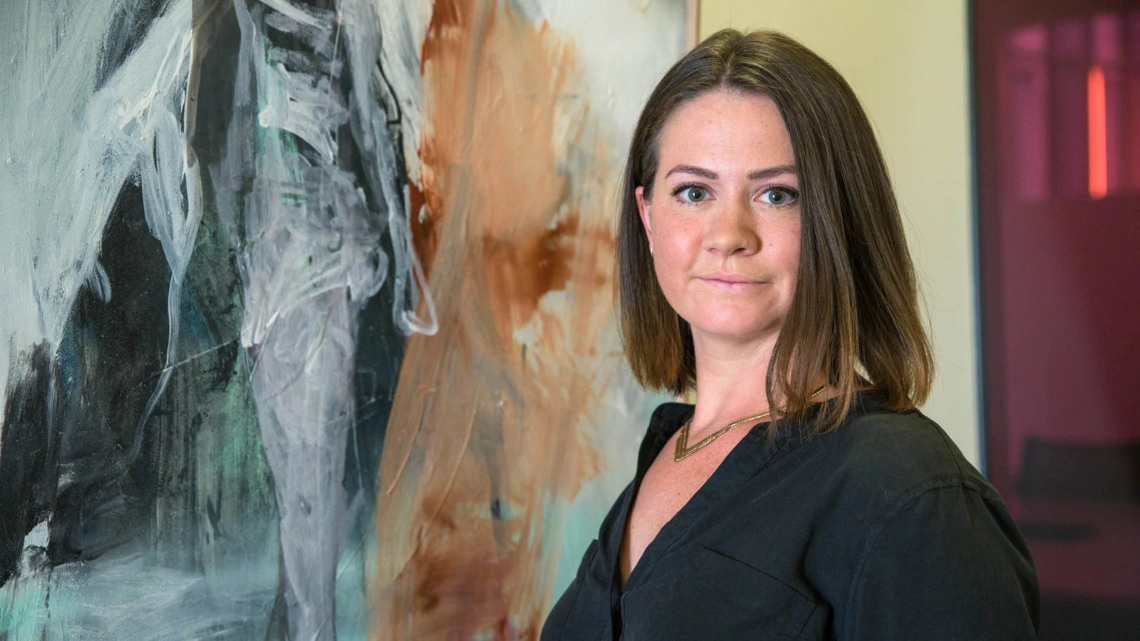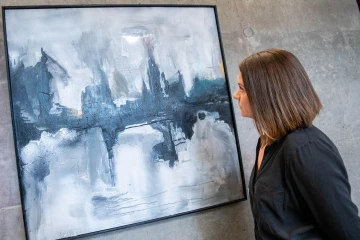Phoenix Surgery Resident Finds Solace in Art
Dr. Harriet Barratt, a fifth-year surgery resident, used her clinical experiences to inspire her latest artwork.

Harriet Barratt, MD, poses in front of her painting Stance, an acrylic spray paint on wood, on the fifth floor of the Health Sciences Education Building in Phoenix.
As the COVID pandemic swept across the country, many doctors found themselves engulfed by its omnipresence. The virus took a physical and mental toll, highlighting the importance for physicians to find an outlet outside of work to ease the stress.

Harriet Barratt, MD, with her painting Fjords, an acrylic spray paint on wood.
For Harriet Barratt, MD, a fifth-year surgery resident, art has always served as a source of inspiration. And as she logged long hours in the COVID intensive care unit, her paintings and ink drawings were a therapeutic exercise for the complex emotions she was processing.
Keep Still Moving Fast — large format paintings — and Trial by Fire — pen and ink drawings — illustrate the juxtaposition of the experiences she had while on rotation in Alaska versus the high-paced environment dictated by the pandemic.
“Even though the two series are visually very different, they are both meant to explore how, over the course of the past two years, COVID has changed the way that we interact with our surroundings,” Dr. Barratt said.
The works, now featured on the fifth floor of the Health Sciences Education Building as a part of the Program of Art in Medicine, were not initially intended to comprise a gallery open to the public.
“These sketches were meant to be an extension of a previous series of work, not necessarily an exhibit of their own,” she explained. “However, as I started putting paint on canvas and ink on paper, I realized that I had something new to say. My experiences in the hospital through COVID have been very inspiring, and the new series took flight shortly after that.”
Dr. Barratt said she has always used her art as an escape – a healthy way to vent after the strains of a tough shift, week or month.
“Trying to put my hopes, frustrations and feelings into paint form helps me rationalize them in a way that is healthy and productive. It is my own mode of therapy,” she said.
Making sure she has time for this passion has only helped her personally and professionally.
“If you express what it is you are passionate about, you will be met with voices of encouragement, both in and out of the hospital. You’d be surprised how many doors can open if you share your hobbies and interests with others,” she said.
Dr. Drane shared that sentiment and noted it is especially important for physicians, who often work long hours and deal with difficult professional situations.
“There are many different types of wellness and mental health practices that everyone can do to be more well and mentally conscious — mindfulness, meditation, gratitude, journaling, exercise, etc.,” he said. “A really effective practice is to stay connected to hobbies, passion projects and things or relationships that bring you joy.”
A version of this story was originally published by the College of Medicine – Phoenix.

